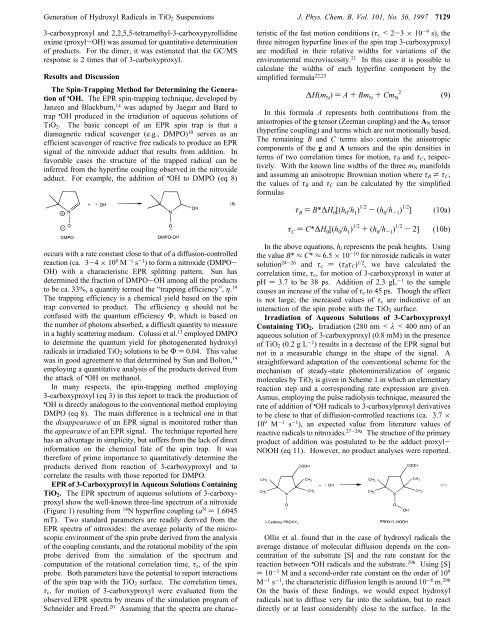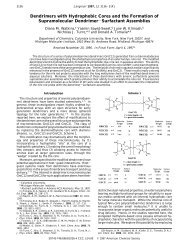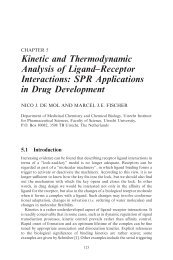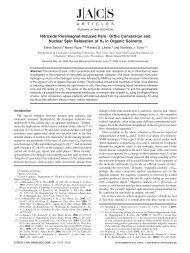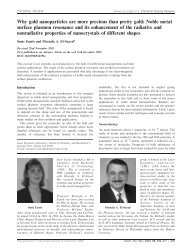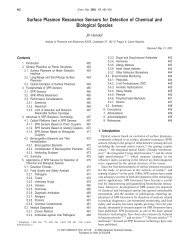A New Method To Determine the Generation of Hydroxyl Radicals in ...
A New Method To Determine the Generation of Hydroxyl Radicals in ...
A New Method To Determine the Generation of Hydroxyl Radicals in ...
You also want an ePaper? Increase the reach of your titles
YUMPU automatically turns print PDFs into web optimized ePapers that Google loves.
<strong>Generation</strong> <strong>of</strong> <strong>Hydroxyl</strong> <strong>Radicals</strong> <strong>in</strong> TiO2 Suspensions J. Phys. Chem. B, Vol. 101, No. 36, 1997 7129<br />
3-carboxyproxyl and 2,2,5,5-tetramethyl-3-carboxypyrollid<strong>in</strong>e<br />
oxime (proxyl-OH) was assumed for quantitative determ<strong>in</strong>ation<br />
<strong>of</strong> products. For <strong>the</strong> dimer, it was estimated that <strong>the</strong> GC/MS<br />
response is 2 times that <strong>of</strong> 3-carboxyproxyl.<br />
Results and Discussion<br />
The Sp<strong>in</strong>-Trapp<strong>in</strong>g <strong>Method</strong> for Determ<strong>in</strong><strong>in</strong>g <strong>the</strong> <strong>Generation</strong><br />
<strong>of</strong> •OH. The EPR sp<strong>in</strong>-trapp<strong>in</strong>g technique, developed by<br />
Janzen and Blackburn, 14 was adapted by Jaegar and Bard to<br />
trap •OH produced <strong>in</strong> <strong>the</strong> irradiation <strong>of</strong> aqueous solutions <strong>of</strong><br />
TiO2. The basic concept <strong>of</strong> an EPR sp<strong>in</strong> trap is that a<br />
diamagnetic radical scavenger (e.g., DMPO) 10 serves as an<br />
efficient scavenger <strong>of</strong> reactive free radicals to produce an EPR<br />
signal <strong>of</strong> <strong>the</strong> nitroxide adduct that results from addition. In<br />
favorable cases <strong>the</strong> structure <strong>of</strong> <strong>the</strong> trapped radical can be<br />
<strong>in</strong>ferred from <strong>the</strong> hyperf<strong>in</strong>e coupl<strong>in</strong>g observed <strong>in</strong> <strong>the</strong> nitroxide<br />
adduct. For example, <strong>the</strong> addition <strong>of</strong> •OH to DMPO (eq 8)<br />
occurs with a rate constant close to that <strong>of</strong> a diffusion-controlled<br />
reaction (ca. 3-4 × 10 9 M -1 s -1 ) to form a nitroxide (DMPO-<br />
OH) with a characteristic EPR splitt<strong>in</strong>g pattern. Sun has<br />
determ<strong>in</strong>ed <strong>the</strong> fraction <strong>of</strong> DMPO-OH among all <strong>the</strong> products<br />
to be ca. 33%, a quantity termed <strong>the</strong> “trapp<strong>in</strong>g efficiency”, η. 19<br />
The trapp<strong>in</strong>g efficiency is a chemical yield based on <strong>the</strong> sp<strong>in</strong><br />
trap converted to product. The efficiency η should not be<br />
confused with <strong>the</strong> quantum efficiency Φ, which is based on<br />
<strong>the</strong> number <strong>of</strong> photons absorbed, a difficult quantity to measure<br />
<strong>in</strong> a highly scatter<strong>in</strong>g medium. Colussi et al. 13 employed DMPO<br />
to determ<strong>in</strong>e <strong>the</strong> quantum yield for photogenerated hydroxyl<br />
radicals <strong>in</strong> irradiated TiO2 solutions to be Φ ) 0.04. This value<br />
was <strong>in</strong> good agreement to that determ<strong>in</strong>ed by Sun and Bolton, 19<br />
employ<strong>in</strong>g a quantitative analysis <strong>of</strong> <strong>the</strong> products derived from<br />
<strong>the</strong> attack <strong>of</strong> • OH on methanol.<br />
In many respects, <strong>the</strong> sp<strong>in</strong>-trapp<strong>in</strong>g method employ<strong>in</strong>g<br />
3-carboxyproxyl (eq 3) <strong>in</strong> this report to track <strong>the</strong> production <strong>of</strong><br />
• OH is directly analogous to <strong>the</strong> conventional method employ<strong>in</strong>g<br />
DMPO (eq 8). The ma<strong>in</strong> difference is a technical one <strong>in</strong> that<br />
<strong>the</strong> disappearance <strong>of</strong> an EPR signal is monitored ra<strong>the</strong>r than<br />
<strong>the</strong> appearance <strong>of</strong> an EPR signal. The technique reported here<br />
has an advantage <strong>in</strong> simplicity, but suffers from <strong>the</strong> lack <strong>of</strong> direct<br />
<strong>in</strong>formation on <strong>the</strong> chemical fate <strong>of</strong> <strong>the</strong> sp<strong>in</strong> trap. It was<br />
<strong>the</strong>refore <strong>of</strong> prime importance to quantitatively determ<strong>in</strong>e <strong>the</strong><br />
products derived from reaction <strong>of</strong> 3-carboxyproxyl and to<br />
correlate <strong>the</strong> results with those reported for DMPO.<br />
EPR <strong>of</strong> 3-Carboxyproxyl <strong>in</strong> Aqueous Solutions Conta<strong>in</strong><strong>in</strong>g<br />
TiO2. The EPR spectrum <strong>of</strong> aqueous solutions <strong>of</strong> 3-carboxyproxyl<br />
show <strong>the</strong> well-known three-l<strong>in</strong>e spectrum <strong>of</strong> a nitroxide<br />
(Figure 1) result<strong>in</strong>g from 14 N hyperf<strong>in</strong>e coupl<strong>in</strong>g (a N ) 1.6045<br />
mT). Two standard parameters are readily derived from <strong>the</strong><br />
EPR spectra <strong>of</strong> nitroxides: <strong>the</strong> average polarity <strong>of</strong> <strong>the</strong> microscopic<br />
environment <strong>of</strong> <strong>the</strong> sp<strong>in</strong> probe derived from <strong>the</strong> analysis<br />
<strong>of</strong> <strong>the</strong> coupl<strong>in</strong>g constants, and <strong>the</strong> rotational mobility <strong>of</strong> <strong>the</strong> sp<strong>in</strong><br />
probe derived from <strong>the</strong> simulation <strong>of</strong> <strong>the</strong> spectrum and<br />
computation <strong>of</strong> <strong>the</strong> rotational correlation time, τc, <strong>of</strong> <strong>the</strong> sp<strong>in</strong><br />
probe. Both parameters have <strong>the</strong> potential to report <strong>in</strong>teractions<br />
<strong>of</strong> <strong>the</strong> sp<strong>in</strong> trap with <strong>the</strong> TiO2 surface. The correlation times,<br />
τc, for motion <strong>of</strong> 3-carboxyproxyl were evaluated from <strong>the</strong><br />
observed EPR spectra by means <strong>of</strong> <strong>the</strong> simulation program <strong>of</strong><br />
Schneider and Freed. 20 Assum<strong>in</strong>g that <strong>the</strong> spectra are charac-<br />
teristic <strong>of</strong> <strong>the</strong> fast motion conditions (τc < 2-3 × 10 -9 s), <strong>the</strong><br />
three nitrogen hyperf<strong>in</strong>e l<strong>in</strong>es <strong>of</strong> <strong>the</strong> sp<strong>in</strong> trap 3-carboxyproxyl<br />
are modified <strong>in</strong> <strong>the</strong>ir relative widths for variations <strong>of</strong> <strong>the</strong><br />
environmental microviscosity. 21 In this case it is possible to<br />
calculate <strong>the</strong> widths <strong>of</strong> each hyperf<strong>in</strong>e component by <strong>the</strong><br />
simplified formula 22,23<br />
2<br />
∆H(mN ) ) A + BmN + CmN In this formula A represents both contributions from <strong>the</strong><br />
anisotropies <strong>of</strong> <strong>the</strong> g tensor (Zeeman coupl<strong>in</strong>g) and <strong>the</strong> AN tensor<br />
(hyperf<strong>in</strong>e coupl<strong>in</strong>g) and terms which are not motionally based.<br />
The rema<strong>in</strong><strong>in</strong>g B and C terms also conta<strong>in</strong> <strong>the</strong> anisotropic<br />
components <strong>of</strong> <strong>the</strong> g and A tensors and <strong>the</strong> sp<strong>in</strong> densities <strong>in</strong><br />
terms <strong>of</strong> two correlation times for motion, τB and τC, respectively.<br />
With <strong>the</strong> known l<strong>in</strong>e widths <strong>of</strong> <strong>the</strong> three mN manifolds<br />
and assum<strong>in</strong>g an anisotropic Brownian motion where τB * τC,<br />
<strong>the</strong> values <strong>of</strong> τB and τC can be calculated by <strong>the</strong> simplified<br />
formulas<br />
In <strong>the</strong> above equations, hi represents <strong>the</strong> peak heights. Us<strong>in</strong>g<br />
<strong>the</strong> value B* ≈ C* ≈ 6.5 × 10 -10 for nitroxide radicals <strong>in</strong> water<br />
solution 24-26 and τc ) (τBτC) 1/2 , we have calculated <strong>the</strong><br />
correlation time, τc, for motion <strong>of</strong> 3-carboxyproxyl <strong>in</strong> water at<br />
pH ) 3.7 to be 38 ps. Addition <strong>of</strong> 2.3 gL -1 to <strong>the</strong> sample<br />
causes an <strong>in</strong>crease <strong>of</strong> <strong>the</strong> value <strong>of</strong> τc to 45 ps. Though <strong>the</strong> effect<br />
is not large, <strong>the</strong> <strong>in</strong>creased values <strong>of</strong> τc are <strong>in</strong>dicative <strong>of</strong> an<br />
<strong>in</strong>teraction <strong>of</strong> <strong>the</strong> sp<strong>in</strong> probe with <strong>the</strong> TiO2 surface.<br />
Irradiation <strong>of</strong> Aqueous Solutions <strong>of</strong> 3-Carboxyproxyl<br />
Conta<strong>in</strong><strong>in</strong>g TiO2. Irradiation (280 nm < λ < 400 nm) <strong>of</strong> an<br />
aqueous solution <strong>of</strong> 3-carboxyproxyl (0.8 mM) <strong>in</strong> <strong>the</strong> presence<br />
<strong>of</strong> TiO2 (0.2 g L -1 ) results <strong>in</strong> a decrease <strong>of</strong> <strong>the</strong> EPR signal but<br />
not <strong>in</strong> a measurable change <strong>in</strong> <strong>the</strong> shape <strong>of</strong> <strong>the</strong> signal. A<br />
straightforward adaptation <strong>of</strong> <strong>the</strong> conventional scheme for <strong>the</strong><br />
mechanism <strong>of</strong> steady-state photom<strong>in</strong>eralization <strong>of</strong> organic<br />
molecules by TiO2 is given <strong>in</strong> Scheme 1 <strong>in</strong> which an elementary<br />
reaction step and a correspond<strong>in</strong>g rate expression are given.<br />
Asmus, employ<strong>in</strong>g <strong>the</strong> pulse radiolysis technique, measured <strong>the</strong><br />
rate <strong>of</strong> addition <strong>of</strong> • OH radicals to 3-carboxylproxyl derivatives<br />
to be close to that <strong>of</strong> diffusion-controlled reactions (ca. 3.7 ×<br />
10 9 M -1 s -1 ), an expected value from literature values <strong>of</strong><br />
reactive radicals to nitroxides. 27-29a The structure <strong>of</strong> <strong>the</strong> primary<br />
product <strong>of</strong> addition was postulated to be <strong>the</strong> adduct proxyl-<br />
NOOH (eq 11). However, no product analyses were reported.<br />
Ollis et al. found that <strong>in</strong> <strong>the</strong> case <strong>of</strong> hydroxyl radicals <strong>the</strong><br />
average distance <strong>of</strong> molecular diffusion depends on <strong>the</strong> concentration<br />
<strong>of</strong> <strong>the</strong> substrate [S] and <strong>the</strong> rate constant for <strong>the</strong><br />
reaction between • OH radicals and <strong>the</strong> substrate. 29b Us<strong>in</strong>g [S]<br />
) 10 -3 M and a second-order rate constant on <strong>the</strong> order <strong>of</strong> 10 9<br />
M -1 s -1 , <strong>the</strong> characteristic diffusion length is around 10 -8 m. 29b<br />
On <strong>the</strong> basis <strong>of</strong> <strong>the</strong>se f<strong>in</strong>d<strong>in</strong>gs, we would expect hydroxyl<br />
radicals not to diffuse very far <strong>in</strong>to <strong>the</strong> solution, but to react<br />
directly or at least considerably close to <strong>the</strong> surface. In <strong>the</strong><br />
(9)<br />
τ B ) B*∆H 0 [(h 0 /h 1 ) 1/2 - (h 0 /h -1 ) 1/2 ] (10a)<br />
τ C ) C*∆H 0 [(h 0 /h 1 ) 1/2 + (h 0 /h -1 ) 1/2 - 2] (10b)


